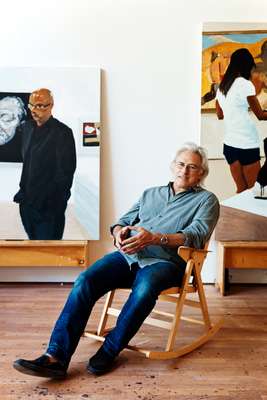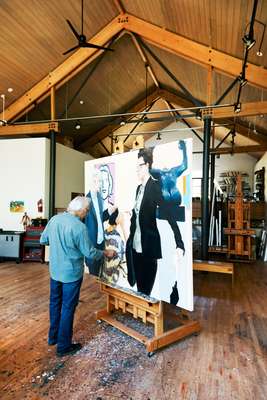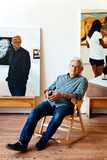Eric Fischl / New York
Art on show
The distinct portraiture of American painter and sculptor Eric Fischl helped define US art during the 1970s and 1980s by defying concepts, fads and fashions. Here he talks about a new series inspired by art fairs and his approach to work.
“I only paint one painting at a time and when I work on a painting, I try to paint every day. My studio is at my home in North Haven on Long Island. I like to go into my studio around 10.00 and feel that there’s activity, feel that there’s stuff going on, whether it’s drawing, sculpting, painting or collaging. On good days I’ll do four hours of concentrated work; sometimes I paint for only 20 minutes to an hour.
Right now I’m completing an exhibition for the Victoria Miro gallery in London so I’m working to finish that up. The paintings are all scenes from art fairs; I think what inspired me was an uncomfortable acceptance that this is the world that I inhabit. I used to never go to art fairs. I thought, ‘This is the worst place for an artist to go, it’s such a crass devolution of culture,’ and I disdained it. It was only a couple of years ago that I went for the first time and my fears were realised but it also became riveting to me and I took lots of pictures. So over the past two years I’ve been to several art fairs – Art Basel was the one that started it, then The Armory Show, Frieze New York and several art fairs in the Hamptons.
Art fairs are like speed dating. The bottom line is that artists are looking for love, they’re looking for understanding and empathy, for inspired exchanges – they’re looking for life and at these fairs all of this is removed or diminished. Inspiration turns to sensation, not to a deep experience. It’s impossible to have a rich moment with art at an art fair; it’s simply about display and sale. People are pressed to choose quickly because of the crowds; you’re looking for an exchange that involves love and you’re given money in return. It’s one of those paradoxes. It defeats the purpose of art and yet we’re trapped in it because it is the art world. It’s enough to make you want to tear your hair out.




I wish art fairs would go away but they’re not going to. The question is what would be the best incarnation of an art fair? You want to create an environment where people come because they’re seeking an intimate experience. When you go to a movie theatre, even though you’re surrounded by several hundred people, you feel alone in your experience with the movie – if there was a way of recreating that for the other visual arts that would be amazing.
The art world has changed over the years on so many levels since I became a professional artist. It’s affected museums: they have to produce income at a much greater level than in the past so they have to do block-buster shows. That’s narrowing the focus on important art because popularity is a qualifying marker.
Back in the late 1960s and early ’70s, when I was becoming an artist, that was an amazing time, a time when everything broke down and a flood of incredible talent and opportunity came in. There was no place left for art within the minimalist genre because they had pretty much exhausted it. I wasn’t a conceptual artist – painting is my strength and my love. Yet painting at that time was under attack – it was considered a dead art. It was passé. Of course that created an enormous opportunity to go and prove people wrong.
I took several years out of school to find my painting voice. I discovered that I was a narrative painter; I created moments by telling myself stories. I chose these moments based on character types and body language that would trigger associations or memories, so I began to focus on that. I looked at where I came from: an upper middle-class family in the post-war first generation of kids who grew up in the suburbs, in a household that was absolutely dysfunctional. My mother was a tragic alcoholic and we spent our lives up until her suicide trying to deal with it, trying to protect her, to save her, to deny that it was happening in public. The experience of living this dual existence – this is the experience that formed my life so my work comes out of that.
The people that I paint are for the most part friends of mine. But they are also people that have contributed to culture and they’ve had an impact on me and on my time. Choosing to paint them is to commemorate that. I see it as something where I’m trying to monumentalise a moment in time with them. One of the best couple portraits that I painted was of Joan Didion and John Gregory Dunne. The paintings that I do are about bringing the viewer into the same moment that I exist in. I’ve always painted from photographs that I’ve taken so even the people in my art-fair paintings are real – I just don’t know them.
How do you know when a painting’s done? It’s always the most difficult thing to figure out. I’m probably a couple of days away from completing my current piece; on average it usually takes about three weeks. There is a point when I step back from my canvas and I look at it not as a painter but as a viewer. I’m looking at a moment and I’m wondering, what the hell’s going on here? Who are these people? What do they want? Then I know the painting’s active and alive. I want to create art that sensitises people to the time they live in, the moment they live in; art that gives them a visual language to see and understand their own experiences.”
‘Eric Fischl: Art Fair Paintings’ is at London’s Victoria Miro gallery during Frieze week from 14 October.


